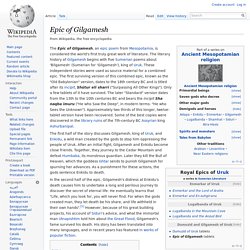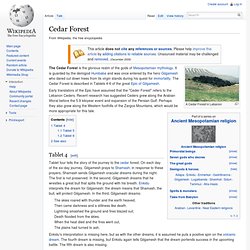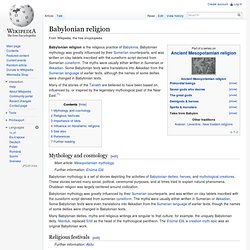

Sumerian religion.
Zu (mythology) In Sumerian and Akkadian mythology, Anzû is a divine storm-bird and the personification of the southern wind and the thunder clouds.

This demon—half man and half bird—stole the "Tablets of Destiny" from Enlil and hid them on a mountaintop. Anu ordered the other gods to retrieve the tablets, even though they all feared the demon. According to one text, Marduk killed the bird; in another, it died through the arrows of the god Ninurta. The bird is also referred to as Imdugud. In Babylonian myth, Anzû is a deity associated with cosmogeny. Jump up ^ Greek Myths and Mesopotamia: Parallels and Influence in the Homeric Hymns and Hesiod. Epic of Gilgamesh. The Epic of Gilgamesh, an epic poem from Mesopotamia, is considered the world's first truly great work of literature.

The literary history of Gilgamesh begins with five Sumerian poems about 'Bilgamesh' (Sumerian for 'Gilgamesh'), king of Uruk. These independent stories were used as source material for a combined epic. The first surviving version of this combined epic, known as the "Old Babylonian" version, dates to the 18th century BC and is titled after its incipit, Shūtur eli sharrī ("Surpassing All Other Kings"). Only a few tablets of it have survived. Gilgamesh. Gilgamesh (/ˈɡɪl.ɡə.mɛʃ/; Akkadian cuneiform: 𒄑𒂆𒈦 [𒄑𒂆𒈦], Gilgameš, often given the epithet of the King, also known as Bilgamesh in the Sumerian texts)[1] was the fifth king of Uruk, modern day Iraq (Early Dynastic II, first dynasty of Uruk), placing his reign ca. 2500 BC.

According to the Sumerian King List he reigned for 126 years. In the Tummal Inscription,[2] Gilgamesh, and his son Urlugal, rebuilt the sanctuary of the goddess Ninlil, in Tummal, a sacred quarter in her city of Nippur. Gilgamesh is the central character in the Epic of Gilgamesh, the greatest surviving work of early Mesopotamian literature.
In the epic his father was Lugalbanda and his mother was Ninsun (whom some call Rimat Ninsun), a goddess. In Mesopotamian mythology, Gilgamesh is a demigod of superhuman strength who built the city walls of Uruk to defend his people from external threats, and travelled to meet the sage Utnapishtim, who had survived the Great Deluge. Cuneiform references[edit] See also[edit] Cedar Forest. A Cedar Forest in Lebanon The Cedar Forest is the glorious realm of the gods of Mesopotamian mythology.

It is guarded by the demigod Humbaba and was once entered by the hero Gilgamesh who dared cut down trees from its virgin stands during his quest for immortality. The Cedar Forest is described in Tablets 4-6 of the great Epic of Gilgamesh. Babylonian religion. Babylonian religion is the religious practice of Babylonia.

Babylonian mythology was greatly influenced by their Sumerian counterparts, and was written on clay tablets inscribed with the cuneiform script derived from Sumerian cuneiform. The myths were usually either written in Sumerian or Akkadian. Some Babylonian texts were translations into Akkadian from the Sumerian language of earlier texts, although the names of some deities were changed in Babylonian texts. Many of the stories of the Tanakh are believed to have been based on, influenced by, or inspired by the legendary mythological past of the Near East.[1] Mythology and cosmology[edit] Babylonian mythology is a set of stories depicting the activities of Babylonian deities, heroes, and mythological creatures. Babylonian mythology was greatly influenced by their Sumerian counterparts, and was written on clay tablets inscribed with the cuneiform script derived from sumerian cuneiform. Religious festivals[edit] Marduk. Marduk (Sumerian spelling in Akkadian: AMAR.UTU 𒀫𒌓 "solar calf"; perhaps from MERI.DUG; Biblical Hebrew מְרֹדַךְ Merodach; Greek Μαρδοχαῖος,[1] Mardochaios) was the Babylonian name of a late-generation god from ancient Mesopotamia and patron deity of the city of Babylon, who, when Babylon became the political center of the Euphrates valley in the time of Hammurabi (18th century BCE), started to slowly rise to the position of the head of the Babylonian pantheon, a position he fully acquired by the second half of the second millennium BCE.

In the city of Babylon, he resided in the temple Esagila.[2]